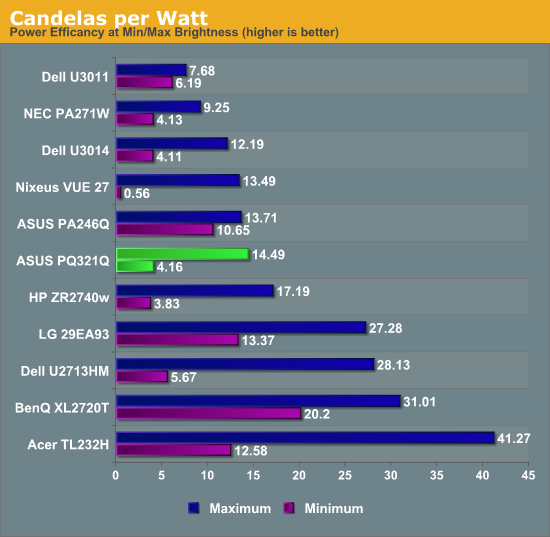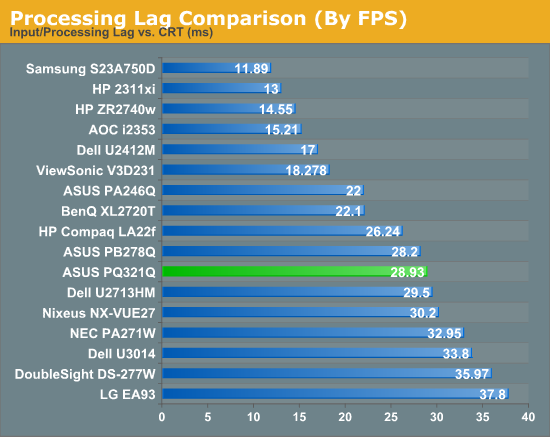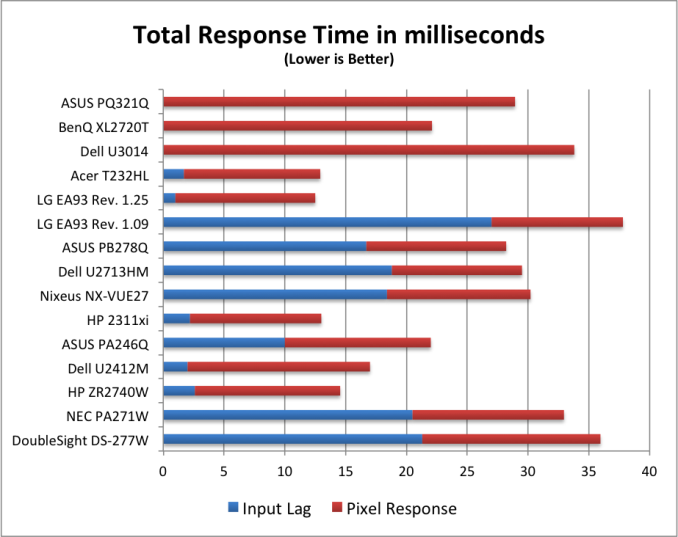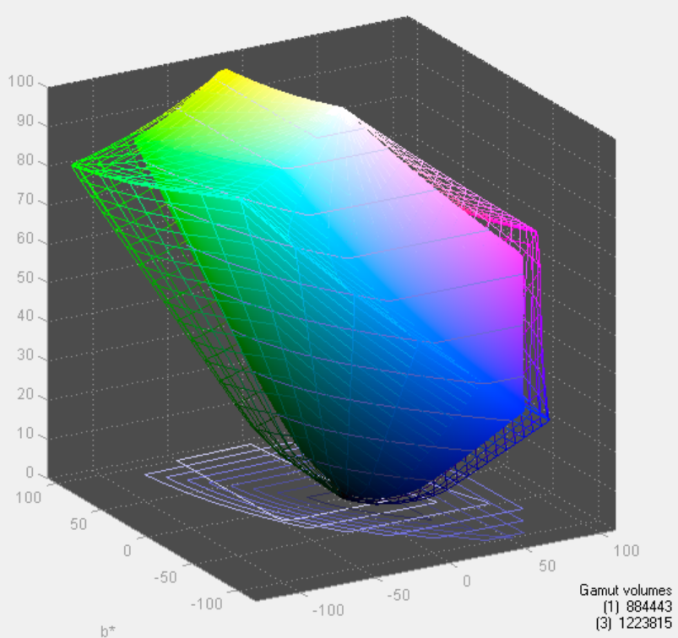ASUS PQ321Q UltraHD Monitor Review: Living with a 31.5-inch 4K Desktop Display
by Chris Heinonen on July 23, 2013 9:01 AM ESTUsing the updated metric for power usage, where I factor in maximum brightness and screen area and not just power usage, the ASUS PQ321Q falls right in the middle of the pack. For both maximum and minimum brightness it does OK but not incredible in comparison to other displays. With the greater transmission of IGZO I would have thought I might see better numbers from the ASUS, but I imagine power usage was very low on the list of concerns relative to other performance numbers.
Overall the ASUS PQ321Q draws a relatively average amount of power compared to other displays.


For testing input lag, I’m again reduced to using the Leo Bodnar lag tester over HDMI. This also means that the ASUS will have to scale the 1080p signal to be 2160p and fill the screen. Unlike before, I think this might be a more accurate test as many people will not be gaming at 2160p yet. Looking at the gaming numbers that our Ian Cutress found with a 4K display, you might want to run at 1080p for a little bit until setting up a 4x Titan rig becomes more affordable. Then again, if you can afford the ASUS PQ321Q, you might be buying a 4x Titan setup as well.
Back to the actual data, and the ASUS comes in at 28.93 ms of lag on average for the 3 measurement locations. This is better than the Dell U3014 monitor does, but slower than the BenQ XL2720T that is a native 1080p display. Given that you have scaling going on here, this actually is a pretty decent result I think.

Despite my GPU only being a GTX 660 Ti, I did try out a little bit of gaming on the ASUS. One question that was debated in Ian’s round-up was the necessity of MSAA at 4K resolutions. Measuring just now, I sit exactly 2’ away from the ASUS PQ321Q, with my eyes around dead center on the display. Turning on Half Life 2 (look, I’m not much of a gamer!), I can easily see the difference between no MSAA, 2x and 4x MSAA. The pixel density would need to be even higher, or I’d need to sit further away, for MSAA to not make a difference.
Without MSAA things still looked very sharp overall, but jagged lines are easy to spot if I look for them. You might be able to more easily get away with 2x or 4x instead of 8x MSAA, but you’ll want to have it enabled. Beyond that, the PQ321Q worked well for my casual gaming. Nothing recognized the display correctly at first, perhaps because of MST, but once in the game you can properly select the 3840x2160 resolution for it.
At the request of a commenter I'm adding some PixPerAn photos, trying to show best and worst case results. I've not used PixPerAn at all before, so feedback would be great. If I've done something wrong with it, I'll try to correct it ASAP.
Looking at the gamut, we see a value that indicates full sRGB gamut coverage. From our earlier images of the CIE diagram we know we don’t have full coverage of red, blue and magenta. It seems the extra green/yellow/orange section is large enough that we get a value that indicates a volume equal to the sRGB space, but some of that volume is an area outside of sRGB. It is close to the sRGB area, but not quite.


















166 Comments
View All Comments
cremefilled - Wednesday, July 24, 2013 - link
Even putting aside your syntax issues, almost all audio equipment depreciates in value quickly. The rare exceptions would be (the minority of) tube based amplification, and maybe a very few speakers (Quad ESL 63's).Calista - Thursday, July 25, 2013 - link
What's even worse, judging from the pictures of the homes of audiophiles the same person spending 10-20k or more on his stereo spend little to no thought on how the room effect the sound. Something we all know is incredibly important for the way sound-waves behave.cheinonen - Thursday, July 25, 2013 - link
As an audiophile as well as a video guy, I don't think the problem is that audiophiles are the worst hobbyists when it comes to paying for diminishing returns. I think the problem is that the press around audio focuses far too much on those diminishing return pieces. I'm considering writing a piece on budget phono amps, as more and more people buy turntables, but it's going to be hard. You can find 100 reviews of a $2,500 phono stage, but none of a $130 one that most people might buy. I think audio has a bad, bad marketing problem that the press reinforces.vgroo - Monday, July 29, 2013 - link
Diminishing returns is an understatement. Whenever I hear the word "audiophile", it always reminds me of those numerous sound-clarifying snakeoil products (e.g. the magnificent Bedini Clarifier, http://www.bedini.com/clarifier.htm) and the praising reviews they get around the web.Shadowself - Wednesday, July 24, 2013 - link
The low end of what anyone with any knowledge of the subject says is *easily* discernible by a person is one arc minute per pixel. (There are things like vernier acuity, rotational acuity and such that can push that by a factor of 10 or more -- to 0.1 arc minute per pixel or less.)A commonly accepted, comfortable viewing angle is 60 degrees. (Some "experts" put it at 90 degrees or more.)
Combining the minimum 1 arc minute per pixel with the minimum 60 degrees gives a horizontal pixel count of 3,600 as the minimum that the average person can easily discern given an optimum viewing distance. (If you take that to the other extreme of 0.1 arc minute and 90 degrees this becomes 54,000 horizontal pixels at the optimum viewing distance.)
So is 2160 (v) x 3820 (h) worth it to the average person with good eye sight? Absolutely. It just barely crosses the 3600 horizontal pixel count.
If you can't tell the difference between UHD (2160p) and HD (1080p) then I humbly submit you need to get your eyes checked. If you can't tell the difference between 720p and 1080p then you REALLY need to get your eyes checked.
1Angelreloaded - Wednesday, July 24, 2013 - link
No believe me playing games for long enough, on low end and high end screens def makes you more aware to PPI, in fact it is funny that most HDTVs look horrible to me, even at the optimized distance. There are things you just notice, if anything I thing being around PC for 2 long makes us somewhat sensitive just like the difference between 30fps and 60fps typically you shouldn't be able to tell a difference but as so many had said yes you can.cremefilled - Wednesday, July 24, 2013 - link
Anyone with knowledge of the subject knows that 60 Hz versus 30 or 24 Hz is easily discernible, and 120 vs 60 is also easily discernible. The confusion here stems from 24 fps being the standard for film, but the difference is that film has built-in artifacts like motion blur that make 24 Hz the bare MINIMUM for smooth motion.If you've seen IMAX presentations, you know that even for true film, 60 vs. 24 is a huge difference.
entrigant - Friday, May 30, 2014 - link
Sound is as quantifiable as video. The accuracy of each can be measured and known beyond question. It's just that nobody does it because they don't want to admit their $2000 stereo is measurably terrible despite how good they've convinced themselves it sounds.ImSpartacus - Tuesday, July 23, 2013 - link
They sit too far away ON AVERAGE.Sitting distance is a random variable and it has non-trivial variance.
I made a spreadsheet to measure this effect: http://goo.gl/dNkj6
n13L5 - Thursday, July 25, 2013 - link
I'm glad I don't have to worry about yanking $ 3.5k from somewhere, cause years of computer use has caused my 20/20 vision to weaken to the point where 1080p on a 27" screen works just fine...